Quill: Introduction
Books before Print – Contrary to the editions published by Johannes Gutenberg and his successors – which consist of multiple copies printed from the same setting of moveable type – manuscript books are unique artefacts created with a pen and ink. But this uniqueness does not mean that medieval scribes tended to work unplanned and unguided by routine. Creating a codex is a craft that requires skills and experience. Scribes are trained by teachers and colleagues; they are formed by tradition (although traditions can differ in time and space, as you will learn). Therefore, their workflows are to a large extent the same. Basically, it all comes down to preparing the writing support, copying, correcting and structuring the text, which will usually be protected by a binding. After completion, books are handed over to readers, who in many cases mark their presence on the page – be it the intended user or later owners. The following introduction describes all these stages in eight short chapters, each one referring to related topics in the Glossary.
1. Choosing a Writing Support
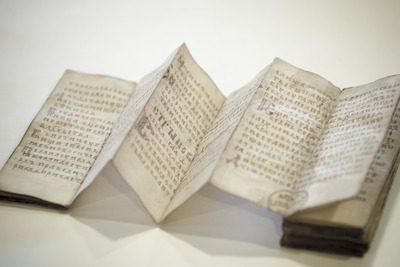
Skins and scraps – For much of the Middle Ages dead cows were the main ingredient for books. What was frolicking in the meadow one month, may have been a page in a Bible the next. The skin of animals - calfs, goats, sheep - was turned into parchment, which was subsequently cut into sheets. Parchment was introduced in late Antiquity, when the codex, the book made of double leaves, was born and started to replace the papyrus scroll. In the 12th century another material appeared in Europe: paper.
Imported from Arabic culture, it was first exclusively used for documentary purposes, such as account books and letters. In a remarkable shift of scribal practices, in the fourteenth century scribes all over Europe started to use paper for manuscripts. Conservative scribes, such as monks, ignored the new material, while others, especially those who wanted to economize, embraced it. Paper and parchment were used for all sorts of manuscripts, from chunky volumes to small folded books.
Read more in the Glossary: Wax Tablet – Parchment – High Quality Parchment – Damaged Parchment – Offcuts – Palimpsest – Paper – Watermark
2. Making Quires and Sheets
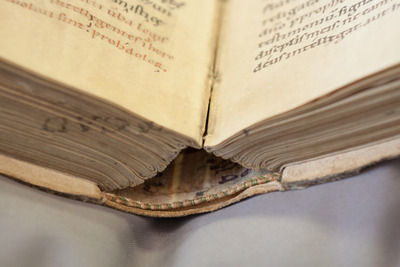
Cuddly quires – While the medieval book was made out of sheets, it is the quire that is the object’s building block. A quire is a small package of folded sheets (bifolia or double-leaves) made of parchment, paper or off-cuts. A medieval book consisted of twenty or more quires, which were held together by a binding. How many bifolia or singletons a scribe would use for a quire depended on his geographical location, among other things.
Copyists in England often opted for six double-leaves, while their continental counterparts almost never did: they favored four. Some late-medieval manuscripts, especially Paris Bibles contained quires with a very high number of bifolia, eighteen or even more. Thick quires are also found up in manuscripts made by chancery clerks, such as account books. When you look at the top or bottom of a manuscript you can easily spot the individual quires, all cuddled up inside the binding.
Read more in the Glossary: Bifolium – Catchwords and Signatures – Quire
3. Preparing the Page

Get set! – Before a single word flowed from his pen, the scribe needed to prepare the page. Whether he had opted for a writing supported material, such as parchment or paper, the sheets were completely blank. He first needed to think about a sensible layout, carefully considering his options. Did the text he was about to copy carry certain conventions? Was it for example a book that was to contain glosses, or was it made for portable use? The design materialized when the scribe started to punch holes in the sheet (pricking) and draw lines between pairs of holes (ruling). Every single word on the page was written on such a line, which was drawn with either pencil or ink, or with a pointy object. Preparing the page was a labor-intensive process, especially when the scribe had opted for a complex layout, with multiple columns and glosses. It was important to get it right, however, as a messy layout would produce a messy book.
Read more in the Glossary: Layout – Pricking and Ruling
4. Copying the Text
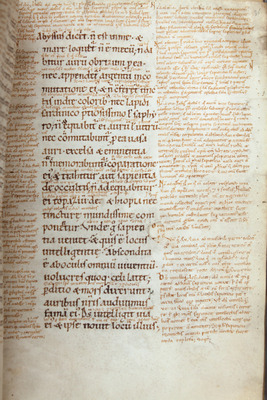
Words, words, words - Parchment makers prepared skins, scribes cut their pens and filled their ink pots, and binders packed their workshops with leather and wood. All these activities would be in vane were it not for the single event that sparked them: copying words. Writing a medieval text with a quill is hard work. ‘The fingers write, but the whole body suffers’ says a medieval saying. The pen could only move downwards because of how the nib was cut, which meant that letters had to be broken up into multiple pen strokes. This made writing a very slow process: a Bible could take a year to complete. A scribe’s handwriting – script - can tell us where and when he was trained to write. Script tells us these things because the shape of letters was constantly changing. Script is thus an important historical tool that helps to place stories and information into the proper cultural-historical setting.
Read more in the Glossary: Abbreviation – Script – Carolingian Script – Cursive Script – Gothic Script – Pre-Gothic Script – Punctuation – Reading Aids – Chapter Number – Paragraph – Rubric – Running Title – Scribal Colophon – Pen Trials – Foliation
5. Correcting the Text
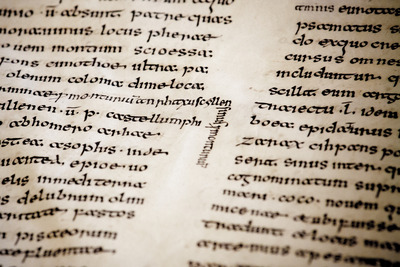
Flaws be gone! – While a Bible may take a year to produce, a mistake was made in a split-second. Even scribes who carefully copied their text, a few words at the time, would ultimately make mistakes. Hasty scribes and those who did not understand the text they copied, usually made many mistakes. An important stage in the production of the medieval book was therefore to correct the text after completion. Some copyists did so superficially, by quickly going through the freshly written pages.
Others did so more meticulously, carefully comparing their copy to the original they had copied. There were various tools to remove flaws from the page. Some were subtle: scribes could inconspicuously add or remove letters, or write on erasure. Other correction practices jumped off the page, like crossing out text or adding omitted text in the margin. Whatever technique the scribe opted for, the ultimate goal was the same, and obvious: flaws be gone!
Read more in the Glossary: Erasure – Insertion – Lacuna – Signe de Revoi
6. Decorating the Book
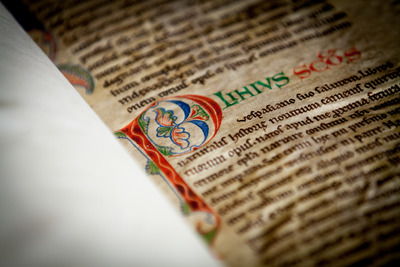
Colorful books – When the quires were filled with text, the rubrics were in place, and the scribe had corrected his work, it was time for the finishing touches. Many medieval books contain some kind of decoration in addition to the written words, usually executed by a different artisan. There is a considerable variation in style and quality of decoration, and, consequently, in cost. At the lower end of the scale is penwork flourishing, red and blue lines drawn with the pen in various patterns and shapes. Some of these typify local styles, allowing us to tie a manuscript to a specific country, city or religious house. At the higher end of the scale is illumination: often sophisticates little paintings that included color and often gold. While decorated books stand out among their other cousins, on the whole they were not very common.
Read more in the Glossary: Doodles – Gilding – Historiated Initial – Miniatures – Penwork Flourishing
7. Binding the Book
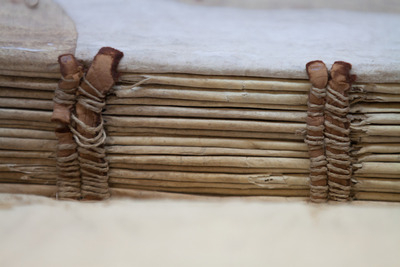
Packing it up – All that was left when the book was copied, corrected and decorated, was to bind the quires together. If a book was made commercially, the client would bring the complete quires to a binder and go over the options. At the lower end of the scale are so-called limp bindings. Such bindings consist of a stiff parchment sheet wrapped around the quires and attached to them with stitches. They were very popular among students because of their low costs.
At the other end of the scale were richly decorated bindings with wooden boards and blind-tooled decoration. The motifs used in the decoration can sometimes help us to relate a binding to a certain atelier or city. Some even tell us who the binder was. ‘Godefridus me fecit’ says a binding produced by Godefridus de Block, a fourteenth-century binder in Brussels. Very rare are so-called ‘treasure bindings’, which covered books, that needed to look handsome and rich, such as gifts or a Gospel Book used for altar display.
Read more in the Glossary: Boards – Limp Binding – Bosses and Clasps – Binding Fragments
8. Using the Book
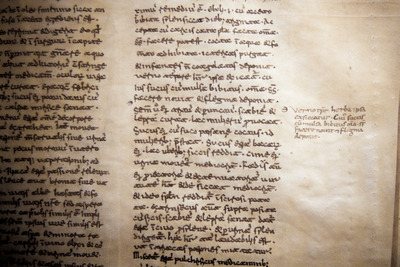
Most medieval bookstores were empty because books were too expensive to have in stock. Instead, each customer would have a long talk with the shopkeeper, who would ask how much he wanted to spend, what materials he preferred, what kind of writing style should be used for the text – and so on. The medieval book is therefore always one of a kind.
Users often modified the manuscript post-production, bringing it even more in tune with their needs. Bookmarks were added for quick access to favorite chapters, while nota signs and maniculae in the margin marked important passages. Glosses and slips with notes were inserted where the text needed clarification.
Read more in the Glossary: Bookmark – Gloss – Manicula – Nota – Notes